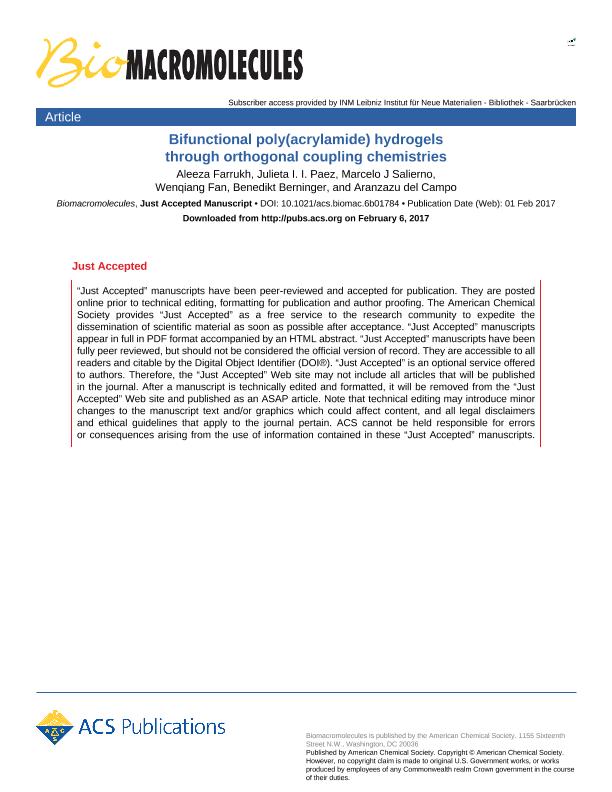Mostrar el registro sencillo del ítem
dc.contributor.author
Farrukh, Aleeza
dc.contributor.author
Paez, Julieta Irene

dc.contributor.author
Salierno, Marcelo Javier

dc.contributor.author
Fan, Wenqiang
dc.contributor.author
Berninger, Benedikt
dc.contributor.author
del Campo, Aránzazu

dc.date.available
2018-09-06T14:13:59Z
dc.date.issued
2017-03
dc.identifier.citation
Farrukh, Aleeza; Paez, Julieta Irene; Salierno, Marcelo Javier; Fan, Wenqiang; Berninger, Benedikt; et al.; Bifunctional Poly(acrylamide) Hydrogels through Orthogonal Coupling Chemistries; American Chemical Society; Biomacromolecules; 18; 3; 3-2017; 906-913
dc.identifier.issn
1525-7797
dc.identifier.uri
http://hdl.handle.net/11336/58491
dc.description.abstract
Biomaterials for cell culture allowing simple and quantitative presentation of instructive cues enable rationalization of the interplay between cells and their surrounding microenvironment. Poly(acrylamide) (PAAm) hydrogels are popular 2D-model substrates for this purpose. However, quantitative and reproducible biofunctionalization of PAAm hydrogels with multiple ligands in a trustable, controlled, and independent fashion is not trivial. Here, we describe a method for bifunctional modification of PAAm hydrogels with thiol- and amine- containing biomolecules with controlled densities in an independent, orthogonal manner. We developed copolymer networks of AAm with 9% acrylic acid and 2% N-(4-(5-(methylsulfonyl)-1,3,4-oxadiazol-2-yl)phenyl)acrylamide. The covalent binding of thiol- and amine-containing chromophores at tunable concentrations was demonstrated and quantified by UV spectroscopy. The morphology, mechanical properties, and homogeneity of the copolymerized hydrogels were characterized by scanning electron microscopy, dynamic mechanical analysis, and confocal microscopy studies. Our copolymer hydrogels were bifunctionalized with polylysine and a laminin-mimetic peptide using the specific chemistries. We analyzed the effect of binding protocol of the two components in the maturation of cultured postmitotic cortical neurons. Our substrates supported neuronal attachment, proliferation, and neuronal differentiation. We found that neurons cultured on our hydrogels bifunctionalized with ligand-specific chemistries in a sequential fashion exhibited higher maturation at comparable culture times than using a simultaneous bifunctionalization strategy, displaying a higher number of neurites, branches, and dendritic filopodia. These results demonstrate the relevance of quantitative and optimized coupling chemistries for the performance of simple biomaterials and with sensitive cell types.
dc.format
application/pdf
dc.language.iso
eng
dc.publisher
American Chemical Society

dc.rights
info:eu-repo/semantics/openAccess
dc.rights.uri
https://creativecommons.org/licenses/by-nc-sa/2.5/ar/
dc.subject
Hydrogels
dc.subject
Poly(Acrylamide)
dc.subject
Biomaterials
dc.subject
Neurons
dc.subject.classification
Otras Ciencias Biológicas

dc.subject.classification
Ciencias Biológicas

dc.subject.classification
CIENCIAS NATURALES Y EXACTAS

dc.subject.classification
Otras Ciencias Químicas

dc.subject.classification
Ciencias Químicas

dc.subject.classification
CIENCIAS NATURALES Y EXACTAS

dc.subject.classification
Biotecnología Industrial

dc.subject.classification
Biotecnología Industrial

dc.subject.classification
INGENIERÍAS Y TECNOLOGÍAS

dc.title
Bifunctional Poly(acrylamide) Hydrogels through Orthogonal Coupling Chemistries
dc.type
info:eu-repo/semantics/article
dc.type
info:ar-repo/semantics/artículo
dc.type
info:eu-repo/semantics/publishedVersion
dc.date.updated
2018-08-31T13:47:57Z
dc.journal.volume
18
dc.journal.number
3
dc.journal.pagination
906-913
dc.journal.pais
Estados Unidos

dc.journal.ciudad
Washington
dc.description.fil
Fil: Farrukh, Aleeza. Leibniz Institute for New Materials; Alemania. Max-Planck-Institut für Polymerforschung; Alemania
dc.description.fil
Fil: Paez, Julieta Irene. Leibniz Institute for New Materials; Alemania. Max-Planck-Institut für Polymerforschung; Alemania
dc.description.fil
Fil: Salierno, Marcelo Javier. Consejo Nacional de Investigaciones Científicas y Técnicas; Argentina. Max-Planck-Institut für Polymerforschung; Alemania. Johannes Gutenberg University; Alemania. Johannes Gutenberg University Mainz; Alemania
dc.description.fil
Fil: Fan, Wenqiang. Johannes Gutenberg University; Alemania. Johannes Gutenberg University Mainz; Alemania
dc.description.fil
Fil: Berninger, Benedikt. Johannes Gutenberg University; Alemania. Johannes Gutenberg University Mainz; Alemania
dc.description.fil
Fil: del Campo, Aránzazu. Leibniz Institute for New Materials; Alemania. Max-Planck-Institut für Polymerforschung; Alemania. Saarland University; Alemania
dc.journal.title
Biomacromolecules

dc.relation.alternativeid
info:eu-repo/semantics/altIdentifier/doi/https://dx.doi.org/10.1021/acs.biomac.6b01784
dc.relation.alternativeid
info:eu-repo/semantics/altIdentifier/url/https://pubs.acs.org/doi/10.1021/acs.biomac.6b01784
Archivos asociados
